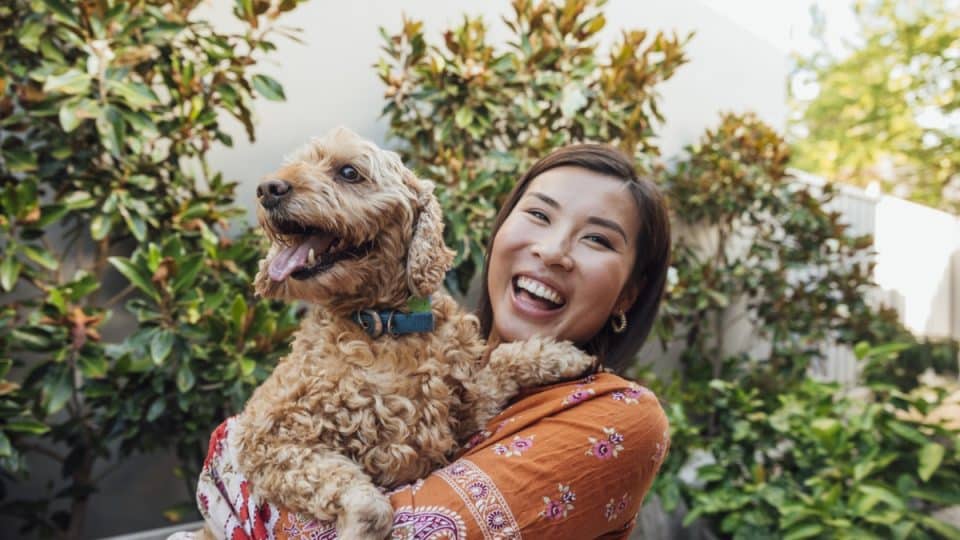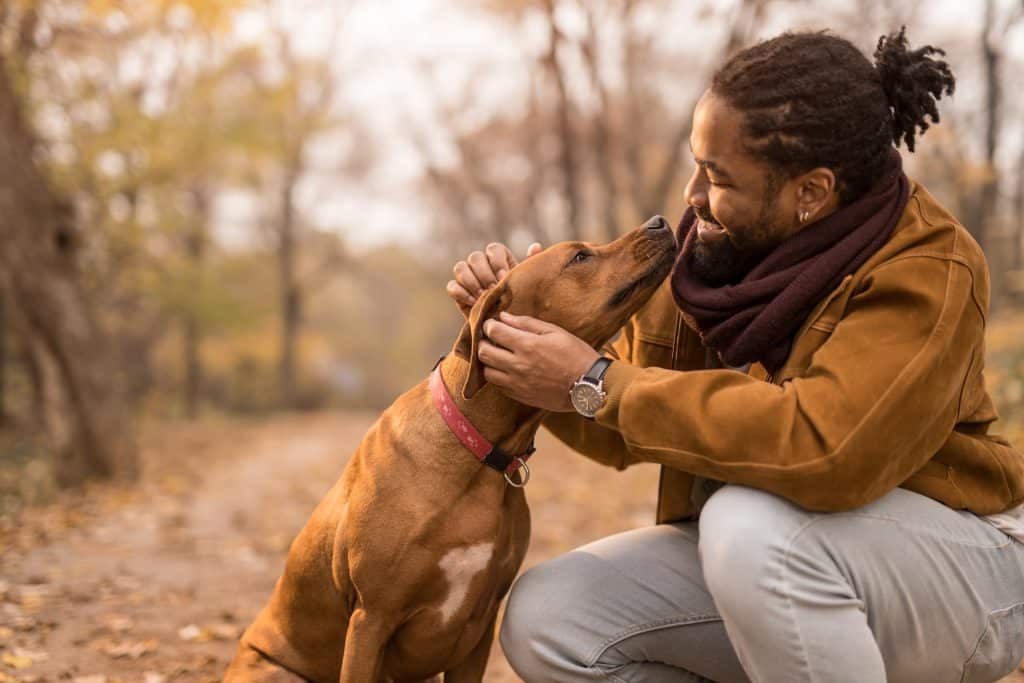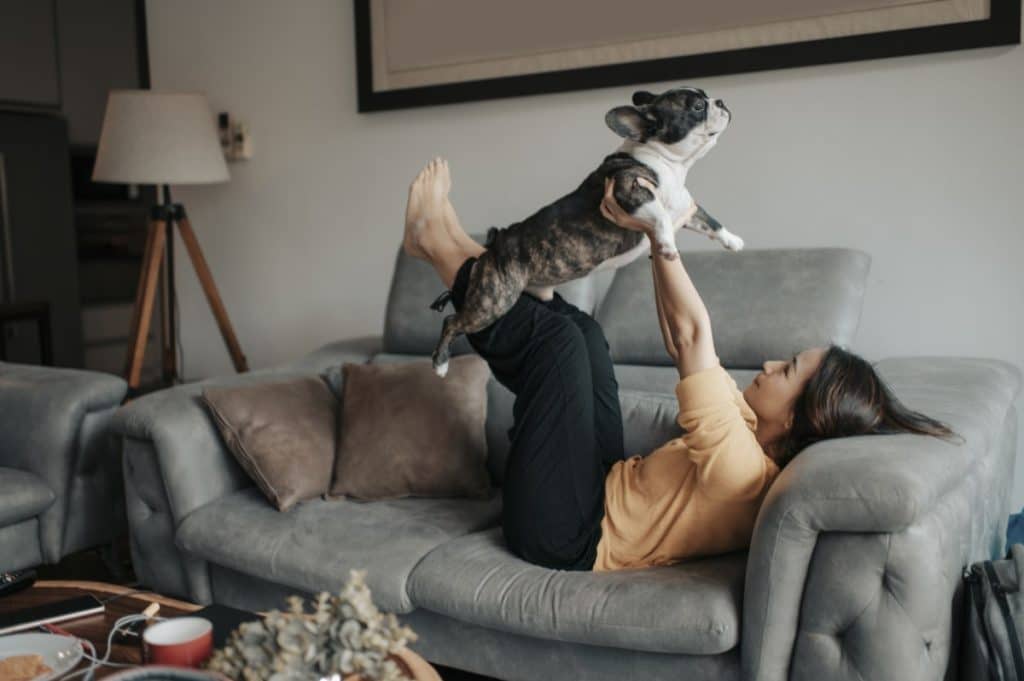- Not a substitute for professional veterinary help.
Dogs who have a strong bond with their people tend to feel more secure and understood. Activities like training, walking, and play time all help you bond with your dog and show you how to better meet their needs.
Your bond with your dog will grow over time, especially when you work to understand your dog’s needs and emotions.
Bonding with your dog can take days, weeks, or months, says Nicole Kohanski, Human-Animal Bond certified by the American Veterinary Medical Association and certified dog behaviorist, trainer, and founder of Wiggle Butt Academy.
Timing depends on a dog’s age and history. For example, it may take longer to bond with rescue dogs than with puppies—but the journey is worth it!
Read on to learn more about bonding activities to try with your dog and how to tell if your efforts are working.
Key Skills To Building a Strong Bond With Your Dog
The following basics can help you build a solid foundation for a strong bond with your dog:
- Understand dog body language: People are just learning what dog body language and emotions mean, and many people have a hard time understanding a dog’s emotional state. However, Kohanski says recognizing what your dog is trying to tell you can strengthen your bond since it helps you give them what they need.
- Be predictable in your communication: Clear, consistent language builds understanding and trust. For example, saying “outside” every time you take your dog out helps them associate the word to the action.
- Show kindness and empathy: Like people, dogs respond to compassion. Patience and gentle words, especially during training, help your dog feel safe and cared for.
- Offer positive reinforcement: Reward the behaviors you want from your dog with treats, praise, or play. Positive reinforcement helps them learn faster, enjoy training, and build trust.
Best Activities for Increasing Your Bond
Building a strong bond with your dog takes time, consistency, and meaningful interaction. The following activities offer practical ways to deepen your connection and create a trusting, loving relationship with your dog.
Have regular positive interactions
Regular positive interactions between dogs and their pet parents can increase oxytocin, also known as the love hormone, which can do a lot to improve your bond. Daily rituals, such as walks and playing a favorite game, also help release oxytocin.
This can reduce stress for both of you and improve your emotional connection.
Try trick training
Kohanski explains that trick training can create memories and shared warm and fuzzy feelings, much like when we have fun with friends or family.
For example, teaching your dog to shake or roll over can be a playful way to engage their mind and keep their attention focused on you. Celebrate small successes with treats or praise for a joyful interaction that helps both of you look forward to training sessions.
Get down to their level
Physical closeness can deepen your connection with your dog by making interactions feel more personal and less intimidating. Dogs also respond positively when people get down to their eye level.
Consider sitting or kneeling when greeting your dog or during training sessions rather than standing over them.
Give them choices
Offering your dog choices during the day helps reduce stress and supports their natural instincts. Kohanski says deciding whether to engage in behaviors like sniffing or foraging gives dogs a sense of control and confidence.
It’s also important to give your dog the choice to move away from you or anyone else if they aren’t in the mood for petting and touch, which respects their boundaries and comfort.
Be their advocate in unfamiliar situations
Understanding your dog’s body language is key to supporting them when they feel uncertain or scared. Acting as your dog’s advocate reassures them that you’re there to protect and support them.
Kohanski explains that noticing early signs of stress, such as lip licking or turning away, allows you to gently remove your dog from uncomfortable situations.
For instance, if your dog seems uneasy around a lot of people, you can calmly guide them to a quieter space.
Use affectionate tones to talk to them
The way you speak to your dog matters as much as what you say.
Dogs respond more positively to affectionate, high-pitched tones. So, when you call your dog over or praise them, aim for a soft, upbeat voice rather than a stern one.
This kind of vocal interaction makes your dog more likely to respond with enthusiasm and strengthens your emotional connection.
Play the 1-2-3 game
The 1-2-3 game is a training tool that helps improve your dog’s focus, especially in distracting situations like walks, says Kohanski.
The predictability and positive engagement can particularly help dogs who are easily distracted or tend to react to their environments.
To play 1-2-3:
- Start indoors, standing still: Say “three” and immediately give a treat. Then try “two, three,” and finally, “one, two, three.” Repeat each step for a couple of minutes.
- Add movement: Walk slowly indoors with your dog on a leash, repeating the sequence and giving a treat.
- Practice outside: Move to a low-distraction outdoor area and repeat these steps.
- Increase distractions: Try the sequence in a more distracting environment, like around other people.
- Use on walks: Play during walks in busy settings. Repeat earlier steps as needed or simply say “one, two, three” before treating.
Talk through your activities or actions
Talk to your dog in a calm and friendly way throughout the day and during tasks. Communicating with your dog while spending time together can help them feel included and reassured.
When preparing their food, for example, you might say, “It’s dinnertime; let’s get your bowl ready!”
Offer special treats
Kohanski explains that treats help dogs associate you with a positive experience, which can make them feel safe and happy.
For shy or fearful dogs, try gently tossing treats from a distance. This allows them to approach on their own terms. Combining choice with reward can help build trust gradually and encourage your dog to feel more comfortable and confident around you.
Be consistent with rules and boundaries
“Dogs thrive when they know what’s expected of them,” Kohanski says. “Consistent rules and boundaries can help your bond as long as they aren’t enforced with pain or suffering.”
Ideally, everyone in the household will follow the same guidelines, such as whether or not your dog is allowed on furniture and how you respond when they jump up on people.
Clear, fair boundaries help your dog feel secure and understand their place in the household.
Signs Your Bond Is Growing
Over thousands of years, dogs have developed human-like ways of communicating, such as responding to eye contact and emotional cues.
Dr. Nell Ostermeier, a veterinarian with Figo Pet Insurance, says every dog shows its bond with its human in unique ways. Common signs of a strong bond include:
- Wanting to be near you
- Snuggling or leaning in for contact
- Staying vigilant or protective
- Seeking your attention
- Engaging more in play or interaction
- Making frequent eye contact
A strong bond doesn’t just feel good. It also supports your dog’s health and happiness.
“Dogs are more likely to be emotionally balanced when they feel safe and content,” Dr. Ostermeier says. That emotional well-being contributes to their physical health, which makes your bond an essential part of your dog’s quality of life.
However, a strong bond can sometimes lead to unwanted behaviors like separation anxiety or aggression due to overprotectiveness.
Dr. Ostermeier recommends consulting your vet, a veterinary behaviorist, or a qualified trainer if the bond seems excessive or problematic.
How Long Does a Bond Take To Develop?
Kohanski explains that the time it takes to bond with a dog can vary, depending on the dog’s background and personality.
Puppies often form strong bonds quickly, sometimes even immediately, especially when play and food are involved.
However, for rescue dogs and dogs with a history of fear or abuse, bonding may take several months. They may need extra time, patience, and consistency to learn that people are safe.
Sharing your dog’s bond
Once you’ve built a strong bond with your dog, you can help other family members or your dog sitter do the same. Share what works, like the words, routines, and activities your dog responds well to.
Some dogs need time to build comfort and trust, especially with new people. With patience and consistency, they can learn to feel safe. Your presence during their interactions with others can also help your dog feel more secure as they form new bonds.






